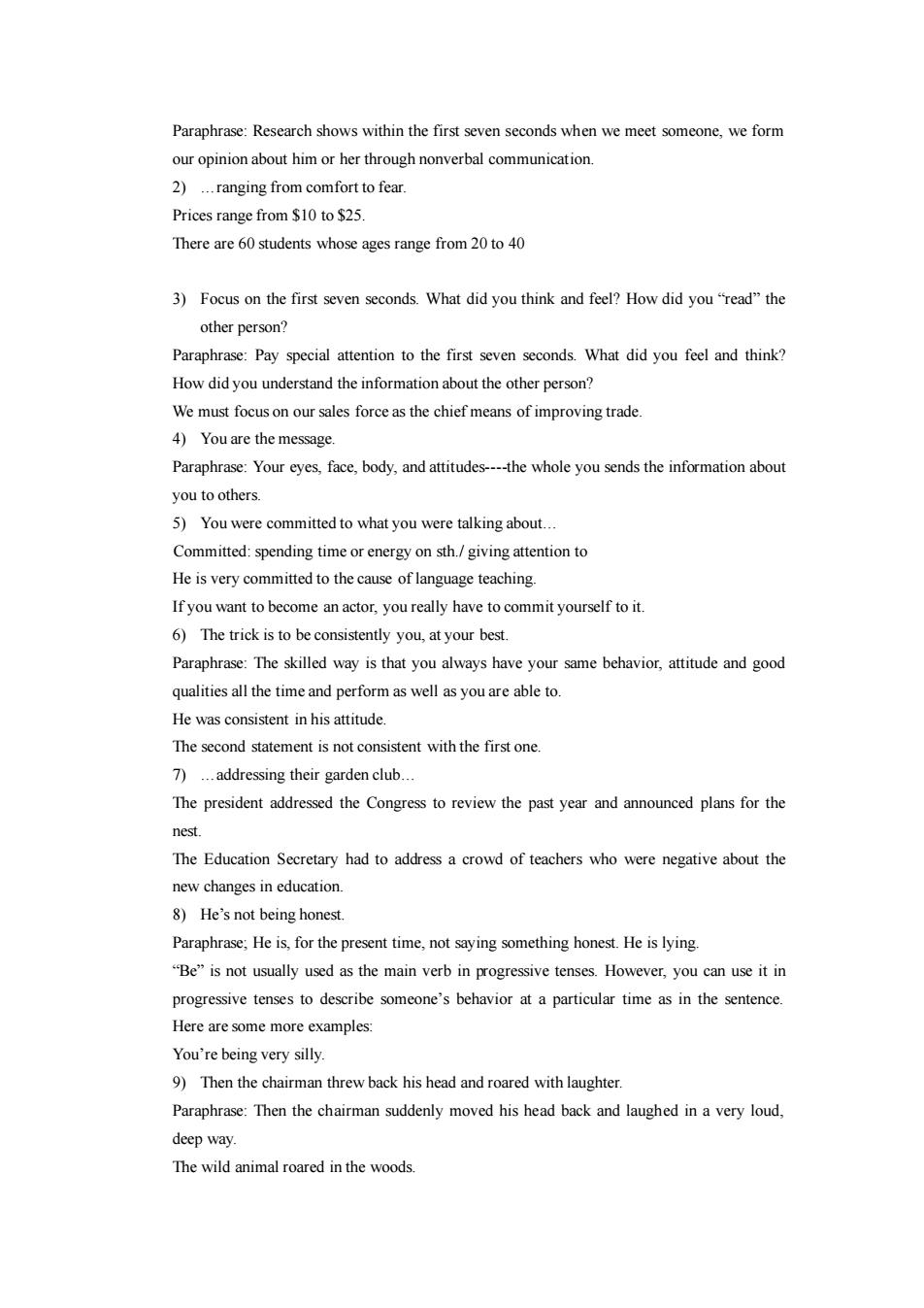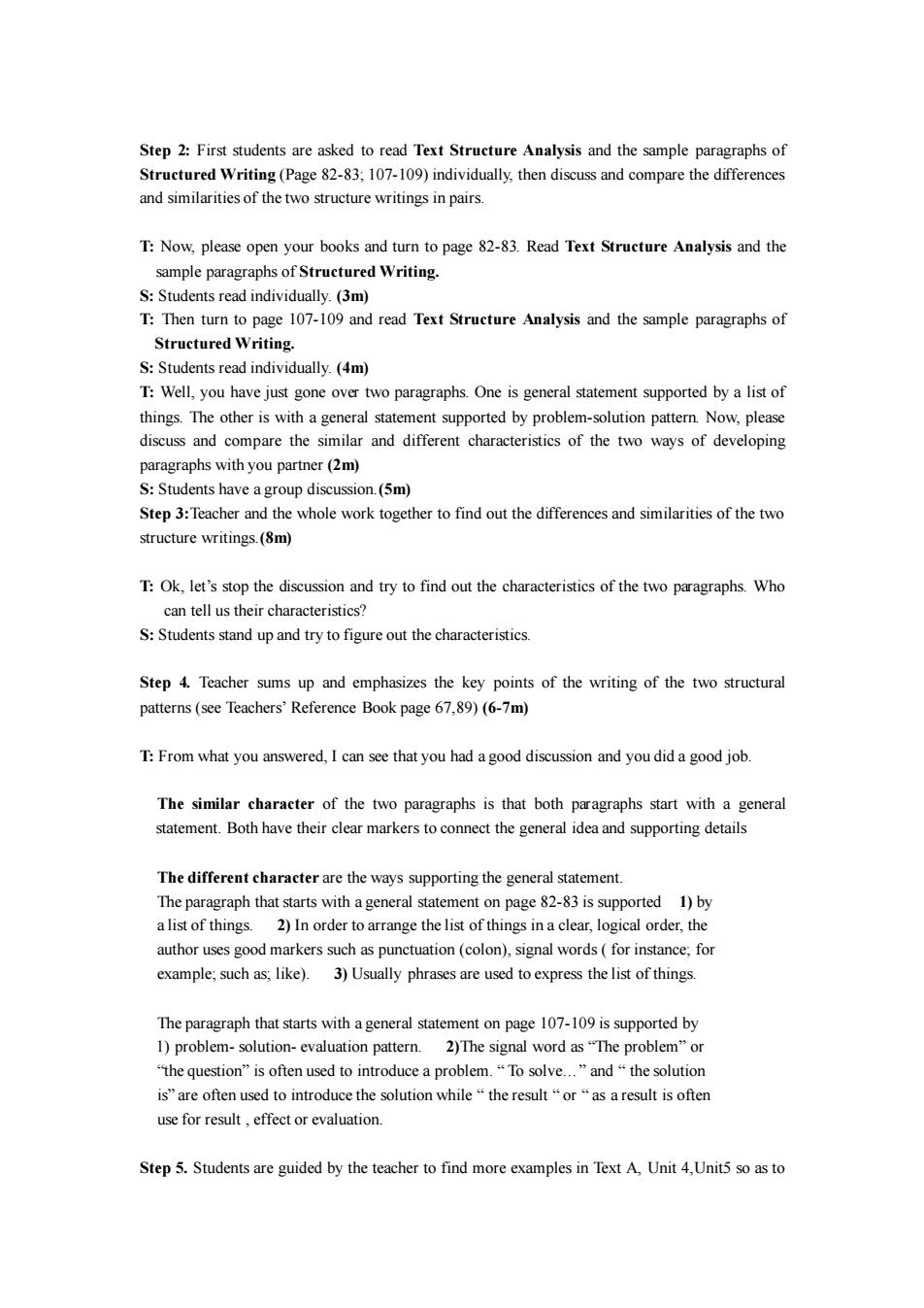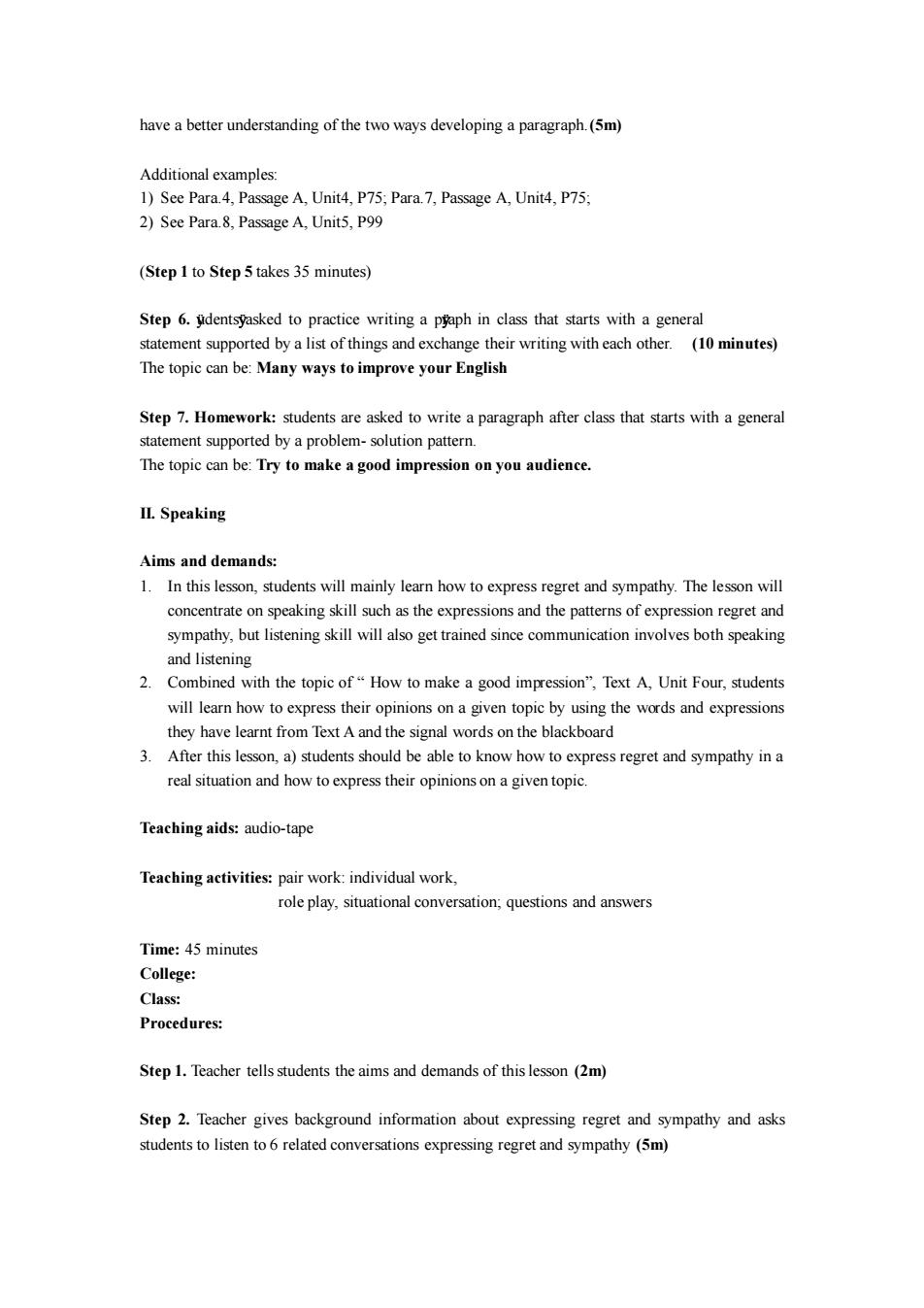
Paraphrase:Researchshows within thefirst seven secondswhen wemeet someone,weformouropinionabouthimorherthroughnonverbal communication.2)...rangingfrom comforttofear.Pricesrangefrom$10to$25There are 60 students whose ages range from 20 to 403)Focus on the first seven seconds. What did you think and feel?How did you"'read"theother person?Paraphrase: Pay special attention to the first seven seconds. What did you feel and think?How did you understand the information about the other person?Wemust focus on oursalesforceas the chiefmeans of improving trade4) You are the message.Paraphrase:Your eyes, face,body,and attitudes----the whole you sends the information aboutyou to others.5)Youwerecommittedtowhatyouweretalkingabout...Committed:spending time orenergyon sth./giving attention toHe is very committed to the cause of language teachingIf you want to become an actor, you really have to commit yourself to it.6) The trick is to be consistently you, at your best.Paraphrase: The skilled way is that you always have your same behavior, attitude and goodqualities all the time and perform as well as youare able to.Hewas consistent inhis attitude.The second statement is not consistent with thefirst one7)...addressing their garden club...Thepresident addressed the Congress toreviewthe past year and announced plansfor thenest.The Education Secretary had to address a crowd of teachers who were negative about thenewchanges ineducation8)He's notbeinghonest.Paraphrase; He is, for the present time, not saying something honest. He is lying“Be" is not usually used as the main verb in progressive tenses. However, you can use it inprogressive tenses to describe someone's behavior at a particular time as in the sentenceHerearesomemoreexamplesYou're being very silly.9)Then the chairman threw back his head and roared with laughterParaphrase:Then the chairman suddenly moved his head back and laughed in a very loud,deep wayThewild animal roared inthewoods
Paraphrase: Research shows within the first seven seconds when we meet someone, we form our opinion about him or her through nonverbal communication. 2) .ranging from comfort to fear. Prices range from $10 to $25. There are 60 students whose ages range from 20 to 40 3) Focus on the first seven seconds. What did you think and feel? How did you “read” the other person? Paraphrase: Pay special attention to the first seven seconds. What did you feel and think? How did you understand the information about the other person? We must focus on our sales force as the chief means of improving trade. 4) You are the message. Paraphrase: Your eyes, face, body, and attitudes-the whole you sends the information about you to others. 5) You were committed to what you were talking about. Committed: spending time or energy on sth./ giving attention to He is very committed to the cause of language teaching. If you want to become an actor, you really have to commit yourself to it. 6) The trick is to be consistently you, at your best. Paraphrase: The skilled way is that you always have your same behavior, attitude and good qualities all the time and perform as well as you are able to. He was consistent in his attitude. The second statement is not consistent with the first one. 7) .addressing their garden club. The president addressed the Congress to review the past year and announced plans for the nest. The Education Secretary had to address a crowd of teachers who were negative about the new changes in education. 8) He’s not being honest. Paraphrase; He is, for the present time, not saying something honest. He is lying. “Be” is not usually used as the main verb in progressive tenses. However, you can use it in progressive tenses to describe someone’s behavior at a particular time as in the sentence. Here are some more examples: You’re being very silly. 9) Then the chairman threw back his head and roared with laughter. Paraphrase: Then the chairman suddenly moved his head back and laughed in a very loud, deep way. The wild animal roared in the woods

The chairman roared with anger when he heard the bad news.C.Post-readingActivity1.Ask students to sumup the main idea of the text and to analyzethe writing techniques of thetext.2.Homework:Learn the words and phrases by heart and next week therewill bea dictation,Doall the exercises on the book withtranslation doneon theexercise book.(2)Period:2periodsTeaching Material:New Horizon College EnglishTeachingProcedure:1Dictationofthewordsandphrases2Commentonandappraisetheexercises.1)Vocabulary:teach studentsthe waytohandlethiskind ofexercise2)Structure:introducemoreabout thefunctions of presentparticiple sothat students canapply this structure to writing.3Translation: teach students the way to translate sentences and compare their version withthat of the text in order that they can gain a better understanding of its nature.3Writing:Sentencespatternstoendaparagraph(Powerpoint如何指导学生写好短文)Teaching Plan for Structural Writing and Speaking (3)I. Structural WritingAims and demands:1.In this lesson, students will mainly learn how to write a paragraph that starts with a generalstatement supported by a list of things.2.Students will learn how to write a paragraph that starts with a general statement supported by aproblem-solution pattern3.After this lesson, a) students should be able to write a paragraph that starts with ageneralstatement supported by a list of thingsb) students should be able to write a paragraph thatstarts with a general statement supported by a problem-solution pattern.c)Students shouldbeableto learntousesignal words related tothetwo ways of developingaparagraph correctlyTeaching methods: student-centered methodTeaching aids: handoutsTeaching activities: group discussion, pair work: individual work, questions and answersTime:45minutesProcedures:Step1:Teacher tells students theaims and demands ofthis lesson (2m)T: Last period, we learned how to develop a paragraph of a general statement supported byexamples. Today we are going to learn how to develop a paragraph of a general statementsupported by a list of things and one supported by problem-solution pattern
The chairman roared with anger when he heard the bad news. C. Post-reading Activity 1.Ask students to sum up the main idea of the text and to analyze the writing techniques of the text. 2.Homework: Learn the words and phrases by heart and next week there will be a dictation; Do all the exercises on the book with translation done on the exercise book. (2) Period:2 periods Teaching Material:New Horizon College English Teaching Procedure: 1 Dictation of the words and phrases 2 Comment on and appraise the exercises. 1) Vocabulary: teach students the way to handle this kind of exercise. 2) Structure: introduce more about the functions of present participle so that students can apply this structure to writing. 3) Translation: teach students the way to translate sentences and compare their version with that of the text in order that they can gain a better understanding of its nature. 3 Writing: Sentences patterns to end a paragraph ( Powerpoint 如何指导学生写好短文) Teaching Plan for Structural Writing and Speaking (3) I. Structural Writing Aims and demands: 1.In this lesson, students will mainly learn how to write a paragraph that starts with a general statement supported by a list of things. 2.Students will learn how to write a paragraph that starts with a general statement supported by a problem- solution pattern. 3.After this lesson, a) students should be able to write a paragraph that starts with a general statement supported by a list of things b) students should be able to write a paragraph that starts with a general statement supported by a problem-solution pattern. c) Students should be able to learn to use signal words related to the two ways of developing a paragraph correctly Teaching methods: student-centered method Teaching aids: handouts Teaching activities: group discussion; pair work: individual work; questions and answers Time: 45 minutes Procedures: Step 1:Teacher tells students the aims and demands of this lesson (2 m) T: Last period, we learned how to develop a paragraph of a general statement supported by examples. Today we are going to learn how to develop a paragraph of a general statement supported by a list of things and one supported by problem-solution pattern

Step 2: First students are asked to read Text Structure Analysis and the sample paragraphs ofStructured Writing(Page 82-83; 107-109) individually, then discuss and compare the differencesand similarities of the two structure writings in pairs.T: Now, please open your books and turn to page 82-83.Read Text Structure Analysis and thesample paragraphs of Structured Writing.S: Students read individually. (3m)T: Then turn to page 107-109 and read Text Structure Analysis and the sample paragraphs ofStructuredWriting.S: Students read individually. (4m)T: Well, you have just gone over two paragraphs. One is general statement supported by a list ofthings. The other is with a general statement supported by problem-solution pattern Now, pleasediscuss and compare the similar and different characteristics of the two ways of developingparagraphs with you partner (2m)S: Students have a group discussion.(5m)Step 3:Teacher and the whole work together to find out the differences and similarities of the twostructure writings.(8m)T: Ok, let's stop the discussion and try to find out the characteristics of the two paragraphs. Whocan tell us their characteristics?S: Students stand up and try to figure out the characteristics.Step 4.Teacher sums up and emphasizes the key points of the writing of the two structuralpatterns (see Teachers'Reference Book page67,89)(6-7m)T:From what you answered, I can see that you had a good discussion and you did a good jobThe similar character of the two paragraphs is that both paragraphs start with a generalstatement.Bothhavetheirclearmarkersto connectthegeneral ideaand supportingdetailsThe different character are the ways supporting the general statement.The paragraph that starts with a general statement on page 82-83 is supported1) bya list of things.2) In order to arrange the list of things in a clear, logical order, theauthor usesgood markers such as punctuation (colon),signal words(for instance,forexample; such as; like).3) Usually phrases are used to express the list of things.The paragraph that starts with a general statement on page 107-109 is supported byI) problem-solution-evaluation pattern.2)The signal word asThe problem"or“"thequestion"is oftenused to introducea problem.“"To solve..."and"the solutionis"are often used to introduce the solution whilethe resultor"as aresult is oftenusefor result,effector evaluationStep 5. Students are guided by the teacher to find more examples in Text A, Unit 4,Unit5 so as to
Step 2: First students are asked to read Text Structure Analysis and the sample paragraphs of Structured Writing (Page 82-83; 107-109) individually, then discuss and compare the differences and similarities of the two structure writings in pairs. T: Now, please open your books and turn to page 82-83. Read Text Structure Analysis and the sample paragraphs of Structured Writing. S: Students read individually. (3m) T: Then turn to page 107-109 and read Text Structure Analysis and the sample paragraphs of Structured Writing. S: Students read individually. (4m) T: Well, you have just gone over two paragraphs. One is general statement supported by a list of things. The other is with a general statement supported by problem-solution pattern. Now, please discuss and compare the similar and different characteristics of the two ways of developing paragraphs with you partner (2m) S: Students have a group discussion.(5m) Step 3:Teacher and the whole work together to find out the differences and similarities of the two structure writings.(8m) T: Ok, let’s stop the discussion and try to find out the characteristics of the two paragraphs. Who can tell us their characteristics? S: Students stand up and try to figure out the characteristics. Step 4. Teacher sums up and emphasizes the key points of the writing of the two structural patterns (see Teachers’ Reference Book page 67,89) (6-7m) T: From what you answered, I can see that you had a good discussion and you did a good job. The similar character of the two paragraphs is that both paragraphs start with a general statement. Both have their clear markers to connect the general idea and supporting details The different character are the ways supporting the general statement. The paragraph that starts with a general statement on page 82-83 is supported 1) by a list of things. 2) In order to arrange the list of things in a clear, logical order, the author uses good markers such as punctuation (colon), signal words ( for instance; for example; such as; like). 3) Usually phrases are used to express the list of things. The paragraph that starts with a general statement on page 107-109 is supported by 1) problem- solution- evaluation pattern. 2)The signal word as “The problem” or “the question” is often used to introduce a problem. “ To solve.” and “ the solution is” are often used to introduce the solution while “ the result “ or “ as a result is often use for result , effect or evaluation. Step 5. Students are guided by the teacher to find more examples in Text A, Unit 4,Unit5 so as to

have a better understanding of the two ways developing a paragraph.(5m)Additionalexamples1)SeePara.4,PassageA,Unit4,P75:Para.7,PassageA,Unit4,P752)SeePara.8,PassageA,Unit5,P9g(Step1 to Step5 takes 35minutes)Step 6. gidentsyasked to practice writing a pyaph in class that starts with a generalstatement supported by a list of things and exchange their writing with each other.(10 minutes)The topic can be: Many ways to improve your EnglishStep 7.Homework: students are asked to write a paragraph after class that starts with a generalstatement supported by a problem- solution pattern.The topic can be:Try to make agood impression on you audienceII. SpeakingAims and demands:1.In this lesson, students will mainly learn how to express regret and sympathy.The lesson willconcentrate on speaking skill such as the expressions and the patterns of expression regret andsympathy, but listening skill will also get trained since communication involves both speakingand listening2.Combined with the topic of" How to make a good impression", Text A, Unit Four, studentswill learn how to express their opinions on a given topic by using the words and expressionstheyhavelearnt from Text A and the signal words on the blackboard3.After this lesson, a) students should be able to know how to express regret and sympathy in areal situation and how to express their opinions on a given topic.Teaching aids: audio-tapeTeaching activities: pair work: individual work,roleplay,situational conversation,questions and answersTime:45minutesCollege:Class:Procedures:Step1.Teacher tells students the aims and demands of this lesson (2m)Step 2.Teacher gives background information about expressing regret and sympathy and asksstudents to listen to 6 related conversations expressing regret and sympathy (5m)
have a better understanding of the two ways developing a paragraph.(5m) Additional examples: 1) See Para.4, Passage A, Unit4, P75; Para.7, Passage A, Unit4, P75; 2) See Para.8, Passage A, Unit5, P99 (Step 1 to Step 5 takes 35 minutes) Step 6. ÿudentsÿ asked to practice writing a pÿraph in class that starts with a general statement supported by a list of things and exchange their writing with each other. (10 minutes) The topic can be: Many ways to improve your English Step 7. Homework: students are asked to write a paragraph after class that starts with a general statement supported by a problem- solution pattern. The topic can be: Try to make a good impression on you audience. II. Speaking Aims and demands: 1. In this lesson, students will mainly learn how to express regret and sympathy. The lesson will concentrate on speaking skill such as the expressions and the patterns of expression regret and sympathy, but listening skill will also get trained since communication involves both speaking and listening 2. Combined with the topic of “ How to make a good impression”, Text A, Unit Four, students will learn how to express their opinions on a given topic by using the words and expressions they have learnt from Text A and the signal words on the blackboard 3. After this lesson, a) students should be able to know how to express regret and sympathy in a real situation and how to express their opinions on a given topic. Teaching aids: audio-tape Teaching activities: pair work: individual work, role play, situational conversation; questions and answers Time: 45 minutes College: Class: Procedures: Step 1. Teacher tells students the aims and demands of this lesson (2m) Step 2. Teacher gives background information about expressing regret and sympathy and asks students to listen to 6 related conversations expressing regret and sympathy (5m)